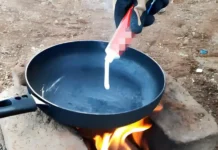What is Paronychia and How to Treat It
Paronychia is a skin infection that causes pus-filled abscesses or boils at the tips of the fingers and toes. It is commonly caused by Staphylococcus aureus (S. aureus) or Herpes simplex virus. This is a common skin condition that, if left untreated or unhygienic, can become chronic and recurrent.
2. Causes of Paronychia in Hands and Feet
Paronychia is an infection at the tip of the finger or toe, usually caused by streptococcal or staphylococcal bacteria. When the skin is scraped, scratched, or cut, especially in people who sweat a lot, bacteria can easily enter through these small wounds and multiply, causing an infection.
Since the wounds are usually minor, people often ignore them and do not seek treatment. Typically, paronychia is not treated during its early stages, and people only seek medical attention when the condition progresses to a severe stage with abscess formation. If left untreated at this stage, paronychia can lead to complications.

3. How Does Paronychia on Fingers and Toes Progress?
Paronychia on fingers or toes typically progresses through three stages:
+ Stage 1: Occurs within the first 1-3 days, with a swollen, red, itchy bump appearing on the fingertip or toe. This then becomes painful and uncomfortable, sometimes leading to stiffness and difficulty moving the affected digit.
+ Stage 2: From days 4-7, the infectious inflammation starts to spread around the finger or toe, causing pain and a feeling of tightness with each pulse. At this stage, the inflammation may cause a low-grade fever.
+ Stage 3: Pus forms at the initial site of swelling. If left untreated or improperly managed, paronychia can lead to complications such as osteomyelitis (bone infection), tenosynovitis (infection of the tendon sheath), arthritis, or sepsis (blood infection).
However, in cases of Herpes-induced paronychia, the incubation period is approximately 2-20 days. General symptoms like fever and fatigue may appear initially, but they are uncommon. More often, individuals experience pain, burning, and tingling sensations in the affected finger joints. Subsequently, the finger joints become red, swollen, and develop fluid-filled blisters (1-3mm in diameter) on the inflamed skin. These blisters may rupture, releasing clear or cloudy fluid, sometimes containing blood.
Following the initial infection, the Herpes virus invades the sensory nerve endings in the skin and travels to the Schwann cells and peripheral nerve ganglia, remaining dormant for extended periods.
When favorable conditions arise, such as immune suppression, psychological stress, or exposure to radiation, ultraviolet light, or laser, the virus reactivates and migrates back to the skin, causing secondary Herpes infections. Typically, primary Herpes infections are more pronounced and intense than secondary infections and have a shorter duration.
4. Differentiating Paronychia from Other Skin Conditions
It is essential to distinguish paronychia from other skin conditions affecting the fingertips and toes, such as:
- Pediculosis: This condition usually causes itching and may lead to mild swelling but rarely results in pain.
- Paronychia: This infection causes swelling, pain, and sometimes pus formation around the nail.
- Melanoma-induced paronychia: This type of paronychia often affects the big toe, causing black discoloration and swelling, often resulting in nail loss.
Paronychia is typically caused by the Herpes virus, with an incubation period of 2–20 days. To differentiate paronychia caused by the Herpes virus from the above-mentioned skin conditions, it is crucial to recognize specific symptoms:
- A burning or tingling sensation in the affected fingertip, like a needle prick.
- Swelling, redness, and the appearance of blisters on the inflamed skin. This stage can last up to 7–10 days.
- Ruptured blisters may release clear, cloudy, or bloody fluid.
- After the initial infection, the Herpes virus invades the sensory nerve endings in the skin and travels to the Schwann cells and peripheral nerve ganglia, remaining dormant until favorable conditions trigger its reactivation and migration back to the skin.
5. Complications of Paronychia
Within the first 7–10 days of the onset of paronychia, the infection can progress to the pus formation stage. If left untreated or inadequately drained, paronychia can lead to the following complications:
- Osteomyelitis (bone infection)
- Arthritis (joint infection)
- Tenosynovitis (infection of the tendon sheath)
- Sepsis (blood infection)
These complications can cause bone inflammation, resulting in swelling, pain, and redness. If left untreated, they may lead to the formation of a sinus tract. X-ray examinations are often recommended to detect and assess these complications. X-ray images may reveal signs of osteomyelitis, with fragments of bone visible. Surgical intervention may be necessary to remove the affected bone. This complication can result in the loss of a phalanx, impacting the overall function of the hand.
6. What to Do If You Have Paronychia on Your Hands
When dealing with paronychia on fingers or toes, it is crucial to take the following steps:
- Maintain hygiene in the affected area by washing the lesion with diluted potassium permanganate solution. After cleaning, apply an antibiotic ointment like Fucidin, Foban, or Bactroban to prevent the spread of infection. However, it is essential to use these medications as directed and under medical supervision.
- In cases of abscess formation, seek immediate medical attention. A healthcare provider will perform an incision and drainage procedure to release the pus. They may also prescribe oral antibiotics.
- If, despite treatment, the affected area remains swollen and painful or does not respond to the initial treatment, X-rays may be recommended to check for possible complications.
To prevent paronychia on fingers and toes, consider the following:
- Maintain good hand and foot hygiene by washing them daily.
- Avoid soaking your hands and feet in water for extended periods.
- Do not walk barefoot, especially on sandy or dusty surfaces.
- Avoid wearing tight-fitting shoes or sandals that may injure your toes.
- When cutting nails, ensure you do not cut them too close to the skin, especially the lateral nail grooves of the fingers and toes. Keep your nails longer than the skin to prevent ingrown nails, which can lead to paronychia.
When dealing with paronychia on the fingertips, the initial focus should be on preventing the spread of infection by maintaining hygiene and applying topical antibiotics. If pus formation occurs, seek immediate medical attention to drain the abscess properly and avoid potential complications arising from delayed or improper treatment.
7. Home Remedies for Paronychia
If you suspect you have paronychia, remain calm and consider trying one of the following four effective home remedies:
7.1 Warm Water Soaks
Warm water can help alleviate the pain associated with paronychia. Adding salt or Epsom salt to the water can further enhance its pain-relieving properties. A high concentration of salt will help reduce swelling caused by paronychia.
Instructions:
- Pour warm water into a container deep enough to soak the affected area. Soak for about 15 minutes.
- Repeat the warm water soak whenever pain occurs.
- After soaking, wrap the affected area with a dry bandage to prevent the spread of infection.
7.2 Antibacterial Soap Soaks
If the blisters have ruptured, add regular or antibacterial soap to warm water and soak the affected finger or toe.
Research suggests that regular soap is as effective as antibacterial soap in protecting against bacteria and infections. Adding soap to the water helps prevent the spread of paronychia as the fluid from the blisters dissolves in the soapy water.
7.3 Ice Packs
Applying extreme cold to the affected area can numb the surrounding nerves and provide pain relief. Additionally, ice packs help slow down blood circulation to the infected area, reducing inflammation and associated pain (if present). You can purchase ice packs from pharmacies or make your own by wrapping ice cubes in a towel and gently applying it to the affected area.
7.4 Vinegar Soaks
This is a simple yet effective home remedy for paronychia. Mix vinegar or apple cider vinegar with water in a 1:4 ratio and soak your hands or feet for 15-20 minutes, then dry thoroughly. For best results, repeat this process 2-3 times a day.
7.5 Epsom Salt Soaks
Epsom salt, or magnesium sulfate, is commonly used in beauty and wellness routines and is an excellent choice for treating paronychia. It helps reduce pain and infection.

Epsom salt soaks are a popular and effective home remedy for paronychia.
Instructions:
– Mix 2 tablespoons of Epsom salt per liter of water.
– Use 1-2 liters of warm water.
– Soak the affected area for 20-25 minutes, then pat dry with a clean towel. Repeat this process 2-4 times a day.
8. Prevention of Paronychia
Paronychia often occurs due to poor hygiene practices. To prevent it, consider the following:
- Maintain good hand and foot hygiene by washing them daily.
- Avoid soaking your hands and feet in water for extended periods.
- Do not walk barefoot, especially on sandy or dusty surfaces, to prevent dirt and bacteria from accumulating in the crevices of your feet.
- Avoid wearing tight-fitting shoes or sandals that may injure your toes.
- When cutting nails, ensure you do not cut them too close to the skin, especially the lateral nail grooves of the fingers and toes. Maintain proper nail hygiene to prevent recurrences.
- Avoid cutting your nails in a curved shape, and do not cut them too short. Instead, cut them straight across and use a nail file to smooth the edges. Maintain nail hygiene to prevent recurrences.

We hope this information has helped you understand paronychia better and provided you with effective treatment and prevention strategies. Remember to seek medical attention if home remedies do not improve your condition or if complications arise.
With over 15 years of experience in web design and development, I have helped hundreds of businesses with their website development and online presence. My expertise lies in creating comprehensive web development plans to ensure sustainable growth and profitability for my clients’ websites.






































